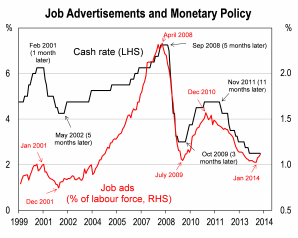Here’s Bloxo in what I consider to be serious premature celebration:
Australia’s labour market is improving and the jobless rate now seems to be passed its peak. Employment rose by +14k jobs (market had +9k; HSBC had +15k) which was enough to hold the unemployment rate steady at 5.8% (market and HSBC had 5.9%). This is down from a peak of 6.0% in February. We expect the labour market to improve further in coming months. Combined with a booming housing market, a strong pick-up in residential construction and rising retail sales, we think this will see the RBA needing to start to move its cash rate back towards neutral before the end of this year. We stick by our view that the RBA will lift rates by Q4.Facts
– Employment increased by +14.2k jobs (market had +9k jobs, HSBC had +15k) to be +0.9% higher y-o-y. Monthly employment growth has averaged +28.5k jobs in the last three months, up from +4.4k jobs in the preceding three months.– The unemployment rate remained steady at 5.8% (market had 5.9%; HSBC had 5.9%), having fallen from a recent high of 6.0% in February 2014.
– The participation rate fell modestly to 64.7% in April, from 64.8% in March. The participation rate has averaged 64.8% over the past three months, from 64.6% in the preceding three months.
Implications
Today brought further evidence that the unemployment rate is likely to have passed its peak. Employment rose by a solid +14k jobs which was enough to keep the unemployment rate steady at 5.8%. This is down from its peak of 6.0% in February.Importantly, this is not the only piece of evidence that suggests the labour market is improving. The business surveys have continued to suggest that hiring intentions have picked up and the job advertisement numbers rose for a fourth consecutive month in April.
An improvement in the labour market is consistent with our long-held view that the rebalancing of growth, from being led by mining investment to the non-mining sectors, would be a net creator of jobs. After all, the parts of the economy that are picking up pace – the housing, consumer and services sectors – are far more labour intensive than the mining sector which is slowing down.
We expect the labour market to continue to improve and for the unemployment rate to fall more rapidly in the second half of this year. If this turns out to be the case, we would also expect businesses to start to consider boosting their new capital spending in coming months, as a lift in hiring is typically accompanied by new investment.
On the rates outlook, history suggests that a turn in the unemployment rate is a necessary condition for the RBA to start lifting its cash rate. If the unemployment rate has passed its peak, as seems likely, this suggests that the next move for the RBA is likely to be up and it is now just a question of timing.
One way to assess timing may be to look at the relationship between the job advertisements numbers, as a share of the labour force, and the cash rate. Adjusting job advertisements in this way tend to make them a smoother guide to turning points in the labour market than the unemployment rate (see Figure 3 below).
The chart shows that previous turns in the cycle of job advertisements have almost always resulted in a change in direction for monetary policy. However, the chart shows that the length of time between the turn in the cycle of job advertisement and a change in the cash rate has varied significantly cycle-to-cycle. Indeed, over the past 15 years the lag has been between 1 and 11 months.
Interestingly though, if this historical relationship holds and given that the job advertisements seemingly turned the corner in January, this historical relationship would suggest that the cash rate could be lifted before the end of this year. This supports our view that the RBA’s next move is up and thait is likely to arrive before year-end. This is well ahead of current market pricing.


